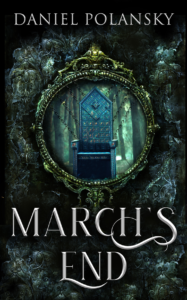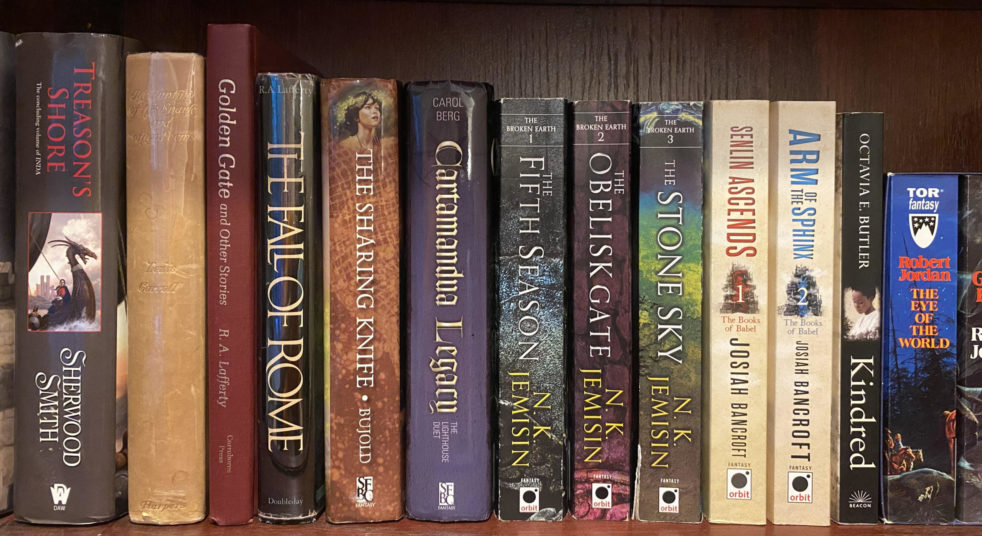
This review is based on an eARC (Advance Reading Copy) provided by the publisher via NetGalley in exchange for an honest review. March’s End will be released on May 9, 2023.
Perhaps this will change, since I seem to have read quite a few of them lately, but I still have a soft spot for portal fantasies. And I found Daniel Polansky’s work quite intriguing when I previously read him at novella length. And somehow I haven’t read many books in the last year with truly weird ecologies, and Bingo season is almost over. Put it all together, and it was time to pick up a copy of March’s End.
March’s End tells the story of one suburban family and their second lives as rulers of The March, a bizarre and fanciful world of sentient trees, mammals, mollusks, bugs, bots, toys, and more. We see through the eyes of Constance, Mary Ann, and John, from their childhood when their parents began grooming them to lead The March, to their adulthood as they’re forced to take up their posts amidst crisis in The March and personal crises back on Earth.
Rather than telling a linear story of the three children becoming adults and taking up their rule, March’s End jumps wildly through the timeline, skipping back and forth between childhood and adulthood and gradually filling in the pieces in between. It doesn’t reveal the ultimate ending up front, but it does skip quickly from the children’s first visit to the March to the week of the story’s ultimate conclusion, leaving the rest of the book to gradually fill in the 25 years of character development leading to the present state of disarray.
And this style is generally effective from a character perspective. The reader knows that Mary Ann and John were estranged from their family and want nothing to do with the March, which gives the flashback sections the tension of waiting for the other shoe to drop. On the other hand, it tends to neglect the immediate aftermath of the other shoe dropping, leading the reader to fill in the details from context clues or secondhand commentary on offscreen actions. Again, from the character perspective, this works well enough. We see the innocent childhoods, the life-changing traumas, and the long-term aftermath. The details in between can be assumed easily enough. But the character climaxes are not always plot climaxes; often enough, the character climaxes are inciting incidents for the plot. So even as the personal stories make sense, the world-level story is missing many of its most epic moments. That’s clearly an intentional choice on the part of the author, but not always a satisfying one.
Perhaps related to the jerky plot progression, when we do, at the end, get a world-shaking epic, it’s so grand that it can be hard to connect. The March is a huge world with so many factions and creatures that the descriptions feel like background noise. Yes, some factions come more into the forefront than others, but even those have the tendency to blend into an amorphous horde, and we don’t know them well enough to generate real emotional investment.
Fortunately, there are plenty of small character stories within the epic that do the story justice, as Mary Ann and John are brought back into the fold and Constance learns how to manage a semi-unified family. It’s very much not an ending that wraps up all of the details, leaving with so many background questions about the world unanswered and the specter of future conflict looming in the distance. That said, there’s enough short-term payoff for some emotional satisfaction. And the unanswered questions don’t feel like cliffhangers so much as intentional ambiguity.
Overall, there are messy characters aplenty and a bunch of good arcs. And if none of the characters are totally likable, they aren’t totally dislikable either. But this is mostly a story of family drama—the big, weird world feels more like background than anything, and climactic plot moments happen off page more than once. For me, the mix makes for a story that I enjoyed reading, but probably not one that I’ll remember among my absolute favorites at the end of the year. That said, your mileage may vary depending on your attitude toward the balance of character, plot, and world.
Recommended if you like: family drama with weird portal fantasy backdrops.
Can I use it for Bingo? I will use it for Weird Ecology, but new Bingo season starts April 1, so anyone who hasn’t already read it will have to check next year’s board. At the very least, it’s bound to fit Published in 2023
Overall rating: 15 of Tar Vol’s 20. Four stars on Goodreads.
